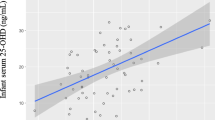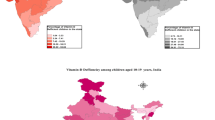Abstract
Vitamin D deficiency (VDD) remains a significant health challenge globally with its overwhelming effects on skeletal growth and varied associations with extra-skeletal diseases. The last decade has reported a high prevalence of VDD in all age-groups across all zones of India. Children and adolescents are most vulnerable to ill-effects of VDD as peak linear growth and bone mass accrual occurs during these years. Vitamin D deficiency in mothers predisposes their infants to have low serum vitamin D levels. Indians have increased susceptibility to develop VDD due to predominant vegetarian dietary habits, high melanin skin content, atmospheric pollution, modest tradition of clothing and limited availability of fortified foods. Vitamin D supplementation during infancy and childhood has emerged as an effective strategy to combat VDD. However, effects of vitamin D supplementation are transient and are not cost-effective as a maintenance strategy. Fortification of foodstuffs has been adopted by many developed countries globally which has emerged as a safe, efficacious and cost-effective strategy to control VDD. A strong political will and support is required to sustain food fortification in India. The current review focuses on strategies to prevent and control the epidemic of VDD in children.
Similar content being viewed by others
References
Mirhosseini N, Rainsbury J, Kimball SM. Vitamin D supplementation, serum 25(oh)d concentrations and cardiovascular disease risk factors: a systematic review and meta-analysis. Front Cardiovasc Med. 2018;5:87.
Martineau AR, Jolliffe DA, Hooper RL, et al. Vitamin D supplementation to prevent acute respiratory tract infections: systematic review and meta-analysis of individual participant data. BMJ. 2017;356:i6583.
Marwaha RK, Tandon N, Agarwal N, et al. Impact of two regimens of vitamin d supplementation on calcium - vitamin D - PTH axis of schoolgirls of Delhi. Indian Pediatr. 2010;47:761–9.
Kapil U, Pandey RM, Sharma B, et al. Prevalence of vitamin D deficiency in children (6-18 years) residing in Kullu and Kangra districts of Himachal Pradesh, India. Indian J Pediatr. 2018;85:344–50.
Kapil U, Pandey RM, Goswami R, et al. Prevalence of vitamin D deficiency and associated risk factors among children residing at high altitude in Shimla district, Himachal Pradesh, India. Indian J Endocrinol Metab. 2017;21:178–83.
Mithal A, Lau E; International Osteoporosis Foundation. The Asian audit: epidemiology, cost and burden of osteoporosis in Asia 2009. Available at URL: https://www.iofbonehealth.org/sites/.../Audit%20Asia/Asian_regional_audit_2009.pdf. Accessed 23 June 2018.
Ross AC, Manson JE, Abrams SA, et al. The 2011 report on dietary reference intakes for calcium and vitamin d from the institute of medicine: what clinicians need to know. J Clin Endocrinol Metab. 2011;96:53–8.
Marwaha RK, Tandon N, Shivprasad C, et al. Peak bone mineral density of physically active healthy Indian men with adequate nutrition and no known current constraints to bone mineralization. J Clin Densitom. 2009;12:314–21.
Munns CF, Shaw N, Kiely M, et al. Global consensus recommendations on prevention and management of nutritional rickets. J Clin Endocrinol Metab. 2016;101:394–415.
Khadilkar A, Khadilkar V, Chinnappa J, et al. Prevention and treatment of vitamin d and calcium deficiency in children and adolescents: Indian Academy of Pediatrics (IAP) guidelines. Indian Pediatr. 2017;54:567–73.
Anderson CM, Gillespie SL, Thiele DK, Ralph JL, Ohm JE. Effects of maternal vitamin D supplementation on the maternal and infant epigenome. Breastfeed Med. 2018;13:371–80.
Marwaha RK, Tandon N, Chopra S, et al. Vitamin D status in pregnant Indian women across trimesters and different seasons and its correlation with neonatal serum 25-hydroxyvitamin D levels. Br J Nutr. 2011;106:1383–9.
Seth A, Marwaha RK, Singla B, et al. Vitamin D nutritional status of exclusively breast fed infants and their mothers. J Pediatr Endocrinol Metab. 2009;22:241–6.
Mehrotra P, Marwaha RK, Aneja S, et al. Hypovitaminosis D and hypocalcemic seizures in infancy. Indian Pediatr. 2010;47:581–6.
De-Regil LM, Palacios C, Lombardo LK, Peña-Rosas JP. Vitamin D supplementation for women during pregnancy. Cochrane Database Syst Rev. 2016;1:CD008873.
Rodriguez A, García-Esteban R, Basterretxea M, et al. Associations of maternal circulating 25-hydroxyvitamin D3 concentration with pregnancy and birth outcomes. BJOG. 2015;122:1695–704.
Zhou SS, Tao YH, Huang K, Zhu BB, Tao FB. Vitamin D and risk of preterm birth: up-to-date meta-analysis of randomized controlled trials and observational studies. J Obstet Gynaecol Res. 2017;43:247–56.
Thorne-Lyman A, Fawzi WW. Vitamin D during pregnancy and maternal, neonatal and infant health outcomes: a systematic review and meta-analysis. Paediatr Perinat Epidemiol. 2012;26:75–90.
Bi WG, Nuyt AM, Weiler H, Leduc L, Santamaria C, Wei SQ. Association between vitamin D supplementation during pregnancy and offspring growth, morbidity, and mortality: a systematic review and meta-analysis. JAMA Pediatr. 2018;172:635–45.
Aghajafari F, Field CJ, Weinberg AR, Letourneau N, APrON Study Team. Both mother and infant require a vitamin d supplement to ensure that infants’ vitamin d status meets current guidelines. Nutrients. 2018;10. https://doi.org/10.3390/nu10040429.
Wei SQ, Qi HP, Luo ZC, Fraser WD. Maternal vitamin D status and adverse pregnancy outcomes: a systematic review and meta-analysis. J Matern Fetal Neonatal Med. 2013;26:889–99.
Hollis BW, Johnson D, Hulsey TC, Ebeling M, Wagner CL. Vitamin D supplementation during pregnancy: double-blind, randomized clinical trial of safety and effectiveness. J Bone Miner Res. 2011;26:2341–57.
Kalra P, Das V, Agarwal A, et al. Effect of vitamin D supplementation during pregnancy on neonatal mineral homeostasis and anthropometry of the newborn and infant. Br J Nutr. 2012;108:1052–8.
Sablok A, Batra A, Thariani K, et al. Supplementation of vitamin D in pregnancy and its correlation with feto-maternal outcome. Clin Endocrinol. 2015;83:536–41.
Darling AL, Rayman MP, Steer CD, Golding J, Lanham-New SA, Bath SC. Association between maternal vitamin D status in pregnancy and neurodevelopmental outcomes in childhood; results from the Avon Longitudinal Study of Parents and Children (ALSPAC). Br J Nutr. 2017;117:1682–92.
Cooper C, Harvey NC, Bishop NJ, et al and the MAVIDOS Study Group. Maternal gestational vitamin D supplementation and off spring bone health (MAVIDOS): a multicentre, double-blind, randomised placebo-controlled trial. Lancet Diabetes Endocrinol. 2016; 4: 393–402.
Puri S, Marwaha RK, Agarwal N, et al. Vitamin D status of apparently healthy schoolgirls from two different socioeconomic strata in Delhi: relation to nutrition and lifestyle. Br J Nutr. 2008;99:876–82.
Pettifor JM. Vitamin D &/or calcium deficiency rickets in infants & children: a global perspective. Indian J Med Res. 2008;127:245–9.
Marwaha RK, Sreenivas V, Talwar D, et al. Impact of solar ultraviolet B radiation (290-320 nm) on vitamin D synthesis in children with type IV and V skin. Br J Dermatol. 2015;173:604–6.
Marwaha RK, Yenamandra VK, Sreenivas V, et al. Regional and seasonal variations in ultraviolet B irradiation and vitamin D synthesis in India. Osteoporos Int. 2016;27:1611–7.
Harinarayan CV, Holick MF, Prasad UV, Vani PS, Himabindu G. Vitamin D status and sun exposure in India. Dermato-endocrinol. 2013;5:130–41.
Meena P, Dabas A, Shah D, Malhotra RK, Madhu SV, Gupta P. Sunlight exposure and vitamin d status in breastfed infants. Indian Pediatr. 2017;54:105–11.
Sacheck JM, Van Rompay MI, Chomitz VR, et al. Impact of three doses of vitamin D3 on serum 25(OH)D deficiency and insufficiency in at-risk schoolchildren. J Clin Endocrinol Metab. 2017;102:4496–505.
Ghazi AA, Hosseinpanah F, M Ardakani E, Ghazi S, Hedayati M, Azizi F. Effects of different doses of oral cholecalciferol on serum 25(OH)D, PTH, calcium and bone markers during fall and winter in school children. Eur J Clin Nutr. 2010;64:1415–22.
Talib HJ, Ponnapakkam T, Gensure R, Cohen HW, Coupey SM. Treatment of vitamin D deficiency in predominantly Hispanic and black adolescents: a randomized clinical trial. J Pediatr. 2016;170:266–72.
Rajakumar K, Moore CG, Yabes J, et al. Effect of vitamin D3 supplementation in black and in white children: a randomized, placebo-controlled trial. J Clin Endocrinol Metab. 2015;100:3183–92.
Lewis RD, Laing EM, Hill Gallant KM, et al. A randomized trial of vitamin D3 supplementation in children: dose-response effects on vitamin D metabolites and calcium absorption. J Clin Endocrinol Metab. 2013;98:4816–25.
Putman MS, Pitts SA, Milliren CE, Feldman HA, Reinold K, Gordon CM. A randomised clinical trial of vitamin D supplementation in healthy adolescents. J Adolesc Health. 2013;52:592–8.
Dong Y, Stallmann-Jorgensen IS, Pollock NK, et al. A 16-week randomized clinical trial of 2000 international units daily vitamin D3 supplementation in black youth: 25-hydroxyvitamin D, adiposity, and arterial stiffness. J Clin Endocrinol Metab. 2010;95:4584–91.
Maalouf J, Nabulsi M, Vieth R, et al. Short- and long-term safety of weekly high-dose vitamin D3 supplementation in school children. J Clin Endocrinol Metab. 2008;93:2693–701.
Arpadi SM, McMahon D, Abrams EJ, et al. Effect of bimonthly supplementation with oral cholecalciferol on serum 25-hydroxyvitamin D concentrations in HIV-infected children and adolescents. Pediatrics. 2009;123:e121–6.
Kuchay MS, Jevalikar GS, Mithal A, Mishra SK, Dang N. Efficacy and safety of a single monthly dose of cholecalciferol in healthy school children. J Pediatr Endocrinol Metab. 2016;29:413–6.
Marwaha RK, Yenamandra VK, Ganie MA, et al. Efficacy of micellized vs. fat-soluble vitamin D3 supplementation in healthy school children from northern India. J Pediatr Endocrinol Metab. 2016;29:1373–7.
Kadappan AS, Guo C, Gumus CE, et al. The efficacy of nanoemulsion-based delivery to improve vitamin D absorption: comparison of in-vitro and in-vivo studies. Mol Nutr Food Res. 2018;62:1700836.
Marwaha RK, Mithal A, Bhari N, et al. Supplementation with three different daily doses of vitamin D3 in healthy pre-pubertal school girls: A cluster randomized trial. Indian Pediatr. 2018; 55:951–56.
Pilz S, März W, Cashman KD, et al. Rationale and plan for vitamin D food fortification: a review and guidance paper. Front Endocrinol (Lausanne). 2018;9:373.
Large Scale Food Fortification in India: The Journey So Far and The Road Ahead. Food Safety Standards Authority of India (FSSAI). Available at URL: https://www.fssai.gov.in/dam/jcr:c746d723.../Large_scale_Food_Fortification.pdf. Accessed on 24 June 2018.
Black LJ, Seamans KM, Cashman KD, Kiely M. An updated systematic review and meta-analysis of the efficacy of vitamin D food fortification. J Nutr. 2012;142:1102–8.
Khadgawat R, Marwaha RK, Garg MK, et al. Impact of vitamin D fortified milk supplementation on vitamin D status of healthy school children aged 10-14 years. Osteoporos Int. 2013;24:2335–43.
Garg MK, Marwaha RK, Khadgawat R, et al. Efficacy of vitamin D loading doses on serum 25-hydroxy vitamin D levels in school going adolescents: an open label non-randomized prospective trial. J Pediatr Endocrinol Metab. 2013;26:515–23.
Author information
Authors and Affiliations
Contributions
RKM: Conception and design of manuscript, led the development of the manuscript and have primary responsibility for the final content. AD: Manuscript preparation and final draft of manuscript. All authors read and approved the final manuscript.
Corresponding author
Ethics declarations
Conflict of Interest
None.
Source of Funding
None.
Additional information
Publisher’s Note
Springer Nature remains neutral with regard to jurisdictional claims in published maps and institutional affiliations.
Rights and permissions
About this article
Cite this article
Marwaha, R.K., Dabas, A. Interventions for Prevention and Control of Epidemic of Vitamin D Deficiency. Indian J Pediatr 86, 532–537 (2019). https://doi.org/10.1007/s12098-019-02857-z
Received:
Accepted:
Published:
Issue Date:
DOI: https://doi.org/10.1007/s12098-019-02857-z




